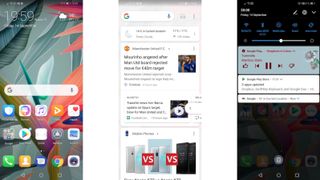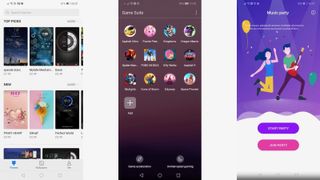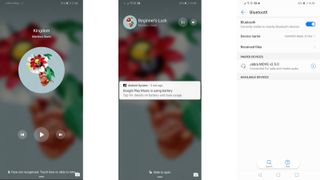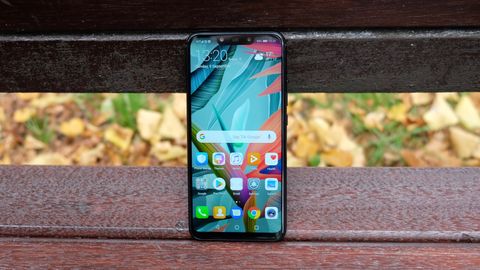Why you can trust TechRadar
Interface and reliability
- Android 8.1 Oreo is now out of date
- EMUI 8.2 is still an acquired taste, to put it mildly
The Huawei Mate 20 Lite runs Android 8.1 Oreo out of the box. That’s no longer the newest version, but Huawei has said that Android 9 will be coming via an update.
Of course, the precise version of Google’s mobile operating system is a secondary issue here, because you get Huawei’s in-your-face EMUI custom interface layered on top. While EMUI has improved considerably over the years, it’s safe to say we’re still not massive fans.
On the plus side, this is a reasonably fluid and solid take on Android. It’s not weighed down with laggy animations or slow transitions, and everything ticks along pretty smoothly.

There’s no superfluous replacement for Google’s feed to the left of the home screen, and Google Assistant is right there under the virtual home key (or waiting to respond to an ‘Okay Google’ vocal prompt).
Our issue with EMUI is more in the lack of taste and discernment on display. Huawei has remolded the app icons, wallpapers, and menus according to its own instincts, many of which happen to align with Apple’s.
There’s a distinct whiff of iOS to the icons, the drag-down file search function, and the lack of an app drawer (though an app drawer can be enabled if you'd prefer).
But unlike iOS, it just doesn’t hang together in an aesthetically cohesive manner. It all feels gaudy and a little bit cheap.

As ever, Huawei has filled the Mate 20 Lite with a whole bunch of its own apps. Many of them seem completely superfluous. You get the Themes app, which lets you customize the look of the phone, including new icons and wallpapers. Having a range of themes at your fingertips is a nice idea, but most of them feel a little naff.
Still, at least Themes has a clear purpose for existing. AppGallery, a third rate alternative to the mighty Google Play Store, really doesn’t.
You could argue that Huawei’s Calendar, Music, Gallery, Email and Notepad have their own clear function, but none are as good as Google’s originals - several of which come pre-installed as confusing duplicates.
Huawei’s Party Mode syncs music playback across phones on the same Wi-Fi network, creating a multi-channel surround sound effect. At least, in theory it does. If you’re like us, you might struggle to find a group of Huawei-owning friends with whom to test it.

In amongst a bunch of basic tool apps, Game Suite is actually pretty interesting. Add downloaded games to this section, and you’ll be able to toggle the Game Acceleration and Uninterrupted Gaming mode.
The former apparently pumps more resources towards these games when they’re running (at the expense of battery life) while the latter minimizes disruptions from notifications.
We can’t say we really noticed a big difference with performance under the Game Acceleration setting, but the Uninterrupted Gaming feature works nicely. Incoming calls appear as a tiny prompt at the top of the screen, and answering those calls places them on speakerphone while you continue playing.
The best thing that can be said for Huawei’s EMUI is that it’s fast and customizable, which doesn’t always apply to some of its rivals. But it’s still a step down from stock Android, any way you cut it.
Movies, music and gaming
- Most video media doesn’t make used of wider screen
- Headphone jack and one underwhelming speaker
- 64GB of storage and microSD up to 256GB
We’re well into the era of the notched smartphone now, with a large portion of new Android phones following the path helpfully popularized by the iPhone X.
One thing that hasn’t changed much in that time, however, is the wider approach to video. The vast majority of video content is still shot at 16:9. This leaves whopping great black borders either side of Netflix videos, or else lops some of the content off with a zoom effect.

Talking of Netflix, it’s curious that Huawei has included it as one of its pre-installed Top Apps when most of its devices don’t support Full HD Netflix playback. Watching 720p content on a 6.3-inch screen isn’t pretty.
YouTube content works much better here. You can watch it natively (in full 1080p) with black borders, or pinch in to expand the screen to a wider but still notch-free look. We actually prefer this interstitial approach to Apple’s fully notched (and thus oddly lopsided) one.
Audio content is well served by the inclusion of a headphone jack, while we found Bluetooth headphones to be easy to connect and stable.

Without such additional gear, the Mate 20 Lite’s audio output isn’t great. Its single bottom-mounted speaker is pretty weedy, and is also way too easy to block whilst gaming. But then, that’s a common complaint south of the flagship line.
When playing music through the included Google Play Music app, we were particular fans of the lock screen widget. It’s tasteful, attractive and useful without being obtrusive.
We’re less keen about the continuous battery notification that accompanied it, though. Yes, we’re aware that the app is ‘using battery’. Now go away.
In terms of media storage, you get a decent 64GB as standard. If that’s not enough, there’s microSD card support for up to 256GB.

Specs and benchmark performance
- Kirin 710 CPU is not spectacular
- 4GB of RAM proves ample
Huawei has fitted the Mate 20 Lite with a Kirin 710 chipset, which is a mid-range chip from affiliate company HiSilicon.
It’s a competent runner, handling general tasks with ease. This is no doubt helped by a decent 4GB of RAM backing it up.
Still, we can’t help but be a little disappointed that we didn’t get something a little meatier. The Kirin 710 isn’t as capable as the Kirin 970 chip that powers the similarly proportioned Honor Play, which actually retails for less.
You’ll also find the Kirin 970 in the Huawei Mate 10 Pro, which is now down around the £400/$550 mark itself, and is a much more accomplished device in most other respects.

In practical terms, gaming performance is okay. Asphalt 9 ran quite well, even when we cranked it up to High settings - though there was the occasional hitch. Guns of Boom positively flies, though, even with 60fps mode active.
PUBG Mobile complained a little more when we bumped its settings up to High/HD, and we also noticed strange visual artefacts, which would seem to point to the use of that less well supported chip. The Kirin 710 simply doesn’t have the level of developer support of, say, the Snapdragon 660 found in the Xiaomi Mi A2 and the Nokia 7 Plus.
In fact, we found that Geekbench 4 wouldn’t even install on our test unit, hence the lack of benchmark information.
While everything runs well through the Kirin 710, it’s hard to shake the feeling that you’re not quite getting the performance you should for the money.
Current page: Anything else I should know?
Prev Page Battery life and camera Next Page Verdict and competition
